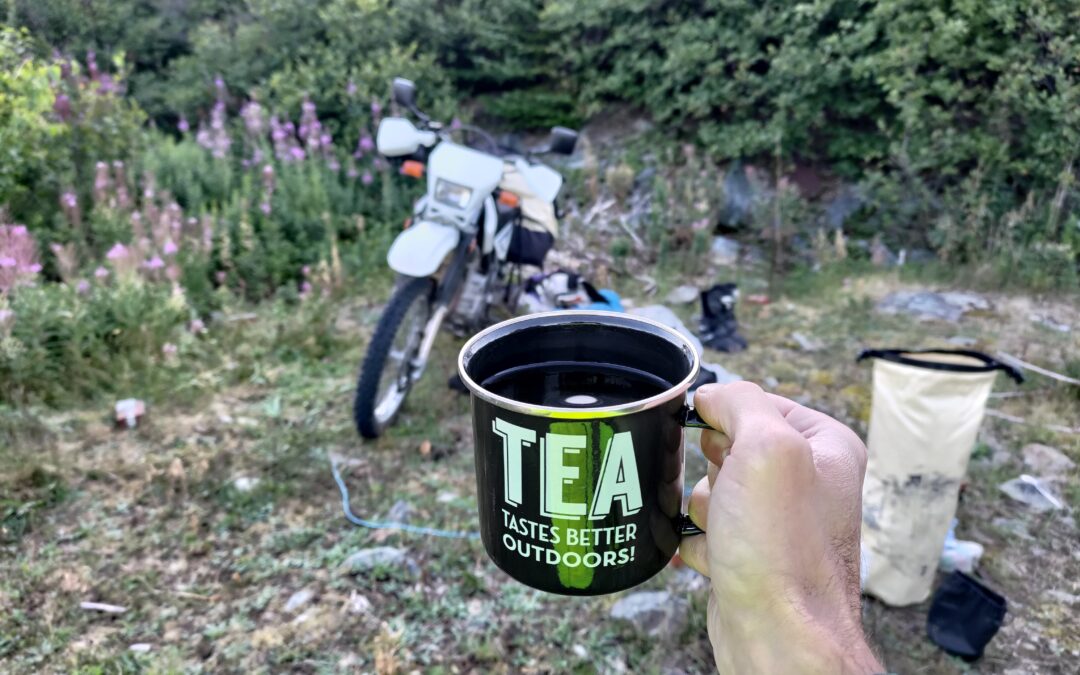On Cape Breton, I continued along the Cabot Trail and spent the first night near a gypsum quarry, which is now flooded and makes for great swimming. On the way out, I laid the bike down for the first time because I decided to try a different route, which turned out to be a much bigger challenge than expected. Luckily, no one was hurt—just as I was heading uphill, the rear wheel slipped, and we tipped over to the side. It was almost at the top. Still, I was pleasantly surprised by what I could handle on this machine.

It rained overnight, so I was glad I had built a good shelter. On Wednesday morning, I realized I wouldn’t be visiting Meat Cove because to make it to the port in North Sydney in time for boarding, I had just enough time if I went straight there. I made it perfectly arrived and immediately boarded the ferry. I had to strap down the bike myself and then made the most of the 7-hour journey on the ship. I explored the whole vessel, spent some time at a charging station, had lunch, and then moved to a chair on the ninth deck.

After disembarking, I changed the time on my watch and rode for about an hour to a river spot I had picked out to camp. Again, it worked out nicely, it only rained at night. However, the place had a lot of mosquitoes, so in the morning I packed up the wet tarp and hit the road. I stopped at a gas station to dry the tarp and got some work done.
As I continued, I discovered the Trans Canada Trail, which follows an old railway and is meant for bikes, hiking, and ATVs and similar vehicles. I jumped on a roughly 60 km stretch, and it was more interesting than the highway. Since it’s mostly used by ATVs and off-road vehicles (like the “side-by-sides” you see in Dakar), I wouldn’t recommend it unless you’re on a mountain bike. For motorcycles, it’s ideal if you’re on a touring enduro—mine feels right at home here. I’m gradually gaining experience and trying to save my tires, which take the most damage on asphalt. You can already see the wear from all the asphalt riding.

This way, I made it to Terra Nova Park and then to the Bonavista Peninsula, where John Cabot supposedly first landed. I found a spot with almost no mosquitoes, which I’m starting to consider a rarity. It’s partly because I want to camp in scenic spots away from the road, which is always appreciated by the local mosquito population. For example, the night before Bonavista, I didn’t sleep much because there were hundreds of mosquitoes, and many found their way under my mosquito net.

In the morning, I visited a bird colony near the town of Elliston, where there are several hundred puffins and other seabirds nesting on a cliff close to the mainland. They’re easy to observe and even photograph with a phone. There used to be a railway here too, and now there’s a trail I wanted to follow all the way to Trinity. It was quite challenging in places with several deep fords, so I wouldn’t want to do it on a bicycle. It was interesting, but you can’t reach Trinity this way anymore—several bridges have collapsed. I turned around at the first one when I saw that the trail wasn’t used much beyond that and didn’t want to take unnecessary risks.

I just rode through Trinity on the motorcycle—it didn’t really appeal to me personally, but I wanted to check out another peninsula with Bay de Verde at the tip, originally a Portuguese fishing settlement. It reminded me a lot of Norway. Tomorrow, I plan to visit St. John’s, so more on that next time.
What I’ve learned over the past week is that a tarp with a mosquito net isn’t a good solution, and next time I’ll only take a tent on such a trip. Also, the motorcycle is well-suited for the local rough roads. I try to avoid highways, and the road conditions off them aren’t great either.
One friend wanted to see my route, so you can check it out here: https://mapy.com/s/losodeveru – it’s only approximate because Mapy doesn’t want to navigate some of the paths I used 😊. I’ll keep adding to it gradually.
All the photos are then in my gallery – https://fotky.kapi.cz/gallery/3IfX7pXDCTXHz-wsPVeS4pKe


It’s amazing. I would never have guessed it was Canada. Thanks for sharing.